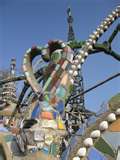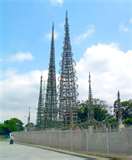Let’s Talk About Race
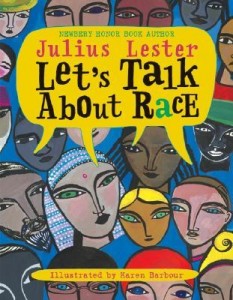 “It is time for parents to teach young people early on that in diversity there is beauty and there is strength.” – Maya Angelou.
“It is time for parents to teach young people early on that in diversity there is beauty and there is strength.” – Maya Angelou.
Next Monday we celebrate the birthday of the Reverend Dr. Martin Luther King, Jr. What better way to honor his dream of a nation where our children “will not be judged by the color of their skin but by the content of their character” than with a wonderful children’s book celebrating our differences and our similarities.
Let’s Talk About Race is written by Julius Lester and illustrated by Karen Barbour. “I am a story,” Lester writes. “So are you. So is everyone.” Our race is just one part of our stories. “To know my story, you have to put together everything I am.”
How does your story begin? When were you born, and who is in your family? What is your favorite food, your religion, your favorite color, your nationality? All of these things are a part of our stories. But, “some stories are true. Some are not. Those who say ‘MY RACE IS BETTER THAN YOUR RACE’ are telling a story that is not true.”
Lester goes on to tell a story that is true: if you press your fingers gently below your eyes, you can feel the bone beneath your skin. And if you press gently on a friend’s face, no matter what their skin color, you will feel the bone there, too. “Beneath our skin I look like you and you look like me…” Instead of focusing on the stories we can make up about each other based on eye color, skin color, and hair texture, we can find out the true stories, the rich and complex stories, of each other.
After you read Let’s Talk About Race with your students, talk about race! And talk about all the other wonderful parts of our stories, from favorite foods to hair color to pet peeves. You can make a questionnaire based on all the elements Lester talks about for students to answer. Next, challenge students to find someone else who had the something the same on his or her list. You can integrate this into a math lesson by graphing some of the answers, like eye color, or get out the art supplies and let students make cool representations of themselves. If your students can “identify the main purpose of a text, including what the author wants to answer, explain, or describe”, you’ll hit the Common Core State Standard of Craft and Structure using a book with a truly worthwhile main purpose.
Read MoreWhat To Do With All That Halloween Candy: Try The Great Graph Contest!
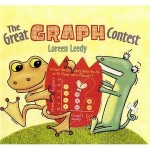 When I was a kid, my brother and I would empty out our bags after trick-or-treating on Halloween and divide the candy into piles: lollipops, bubble gum, candy we were willing to trade, favorites that would be hoarded, etc. I kept careful count of how many of each of my favorites I had, to make sure I’d know if one went missing (my brother was sneaky.) If I’d only had access to The Great Graph Contest by Loren Leedy when I was little, I could’ve made the best kind of bar graph – a candy bar graph – and organized all my trick-or-treat information with real-life math practice.
When I was a kid, my brother and I would empty out our bags after trick-or-treating on Halloween and divide the candy into piles: lollipops, bubble gum, candy we were willing to trade, favorites that would be hoarded, etc. I kept careful count of how many of each of my favorites I had, to make sure I’d know if one went missing (my brother was sneaky.) If I’d only had access to The Great Graph Contest by Loren Leedy when I was little, I could’ve made the best kind of bar graph – a candy bar graph – and organized all my trick-or-treat information with real-life math practice.
In The Great Graph Contest by Loren Leedy, a toad and a lizard compete to see who can make the best graphs. Leedy introduces bar graphs, picture graphs, pie charts, and Venn diagrams simply and with a sense of humor. Your class can use the information on making graphs to practice math with a subject they will find inherently interesting – their candy.
So, share the book with your students (noting with pride how easily you are working the Common Core State Standard of Range of Reading into your curriculum.) Next, get your hands on some candy. You can have students bring in some from home, you can steal from your own kids’ Halloween stash, you can get an assorted bag from the store – if lots of candy in the classroom doesn’t sound like a sweet deal to you, have students just bring in wrappers.
Talk about the different kinds of graphs found in the book, and which would be best suited to organize information about your candy. Sort candies by color of wrapper, ingredients, by beginning letter, etc. Paste wrappers to make a picture graph, or create bar graphs if you have large amounts. Make Venn Diagrams for things like “candies with chocolate”, “candies with nuts” and which candies would be the union. Graphing candy makes for a sweet math activity!
For more information, visit Loren Leedy’s website at: lorenleedy.com.
Read MoreBones: Skeletons and How They Work
I could say, “here’s an informational book that will tickle your funny bone” or “it’s so good it’s scary”, but Bones: Skeletons and How They Work by Steve Jenkins needs no rib-tickling tricks to get kids’ attention. For Halloween or health units, this book is thoroughly engaging. Using cut paper, Jenkins makes incredible illustrations of all kinds of bones to show how structure aids function. Some of the bones are shown actual size, so it’s easy to compare a human skull to that of a baboon, a dog, a parrot, or an armadillo. Some bones are too large to show in actual size, so Jenkins makes the bones to scale. Kids can compare an adult human’s foot bones to the fossil foot bones of a Tyrannosaurus rex! Not only is this book visually a treat, it’s chock-full of “who knew?” facts that kids love: “a giraffe’s neck is as long as a man is tall, but giraffes and humans have the same number of neck bones: seven.”
I love sharing informational books like this with students. With Steve Jenkins’ books, I’m squeezing in the Common Core State Standards of Range of Reading and Key Ideas and Details, I can work interesting books into math and science units, I’m immersing my students in nonfiction, and all the while the kids think they’re just enjoying a good book. Because most of Jenkins’ illustrations are actual size or to scale, you can use Bones: Skeletons and How They Work in a measurement lesson. Kids can estimate how long a bone is and measure it with a ruler. For higher level math, have students measure the to-scale illustrations and multiply to get actual-size measurements.
If you read this book with students around Halloween, it can be a springboard to make some spooky decorations. At enchantedlearning.com, you can print off a human skeleton template for students to cut out and put together with brads to see how all our bones fit. Hang up the skeletons and your decorations are not only scary, they are scientific! For a treat that’s not loaded with sugar, try serving “Bones Dipped in Blood” (pull breadstick dough into bone shapes, bake, and serve with pizza sauce.) To incorporate a bit of technology and to rock it old school, go to YouTube and treat your students to the Schoolhouse Rock video clip of “Them Not-So-Dry Bones”. “Right now there’s a skeleton locked up inside of you!”
For more information, please visit Steve Jenkins’ website: stevejenkinsbooks.com.
Read MoreDream Something Big
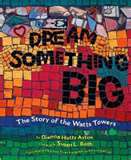 Dream Something Big: the Story of the Watts Towers, written by Dianna Hutts Aston with collages by Susan L. Roth, is a visually stunning biography of an artist you may never have heard of before. Simon Rodia was simply Uncle Sam to his neighbors in Los Angeles. Over 34 years, Sam built towers from broken bits of tile, glass, and cement that soar up to 99 feet high. His incredible recycled-art structures are now a National Landmark.
Dream Something Big: the Story of the Watts Towers, written by Dianna Hutts Aston with collages by Susan L. Roth, is a visually stunning biography of an artist you may never have heard of before. Simon Rodia was simply Uncle Sam to his neighbors in Los Angeles. Over 34 years, Sam built towers from broken bits of tile, glass, and cement that soar up to 99 feet high. His incredible recycled-art structures are now a National Landmark.
At the end of this gorgeously illustrated book you’ll find jaw-dropping photos of the Watts Towers. I’m including a close-up of the towers here so you can see the details as well as a photo that shows just how huge these works of art are. Share Dream Something Big with your students and do a fun math activity. Just how tall is a 99-foot tower? Get out the rulers and chalk and head to the playground or parking lot. Divide 99 by the number of students you have and let them take turns measuring and marking out each foot in 99 feet. Stand at one end of the length when you are done and imagine that distance soaring into the sky. Decorate the 99 feet with chalk “collages”, coloring bright shapes to resemble Sam’s art. Build your own towers with scrap materials, pipe cleaners, clay, etc. and encourage your students to “dream something big” like Sam did. For more inspiration, visit Dianna Hutts Aston’s website: diannahaston.com or Susan Roth’s website: susanlroth.com
Read More




